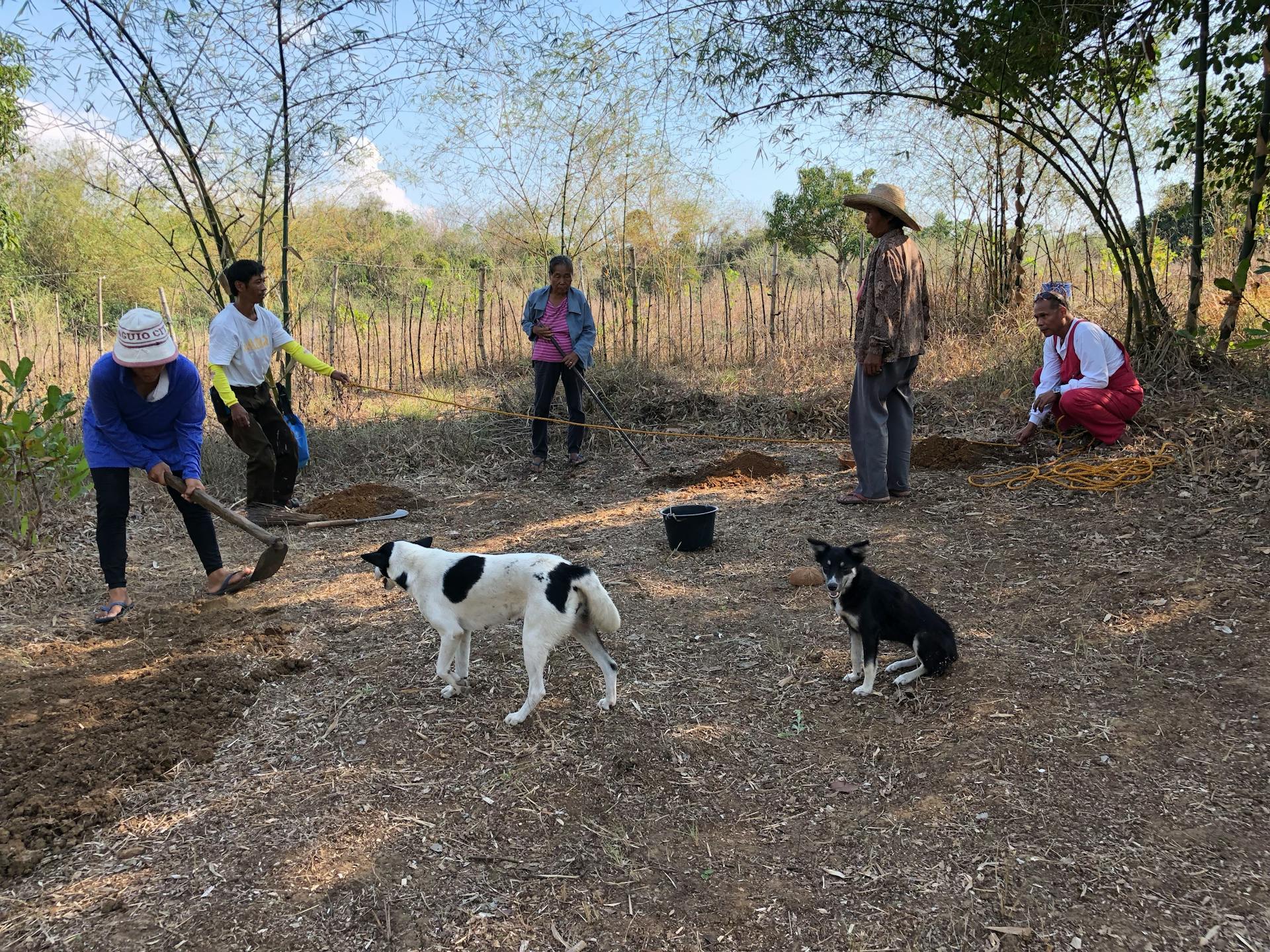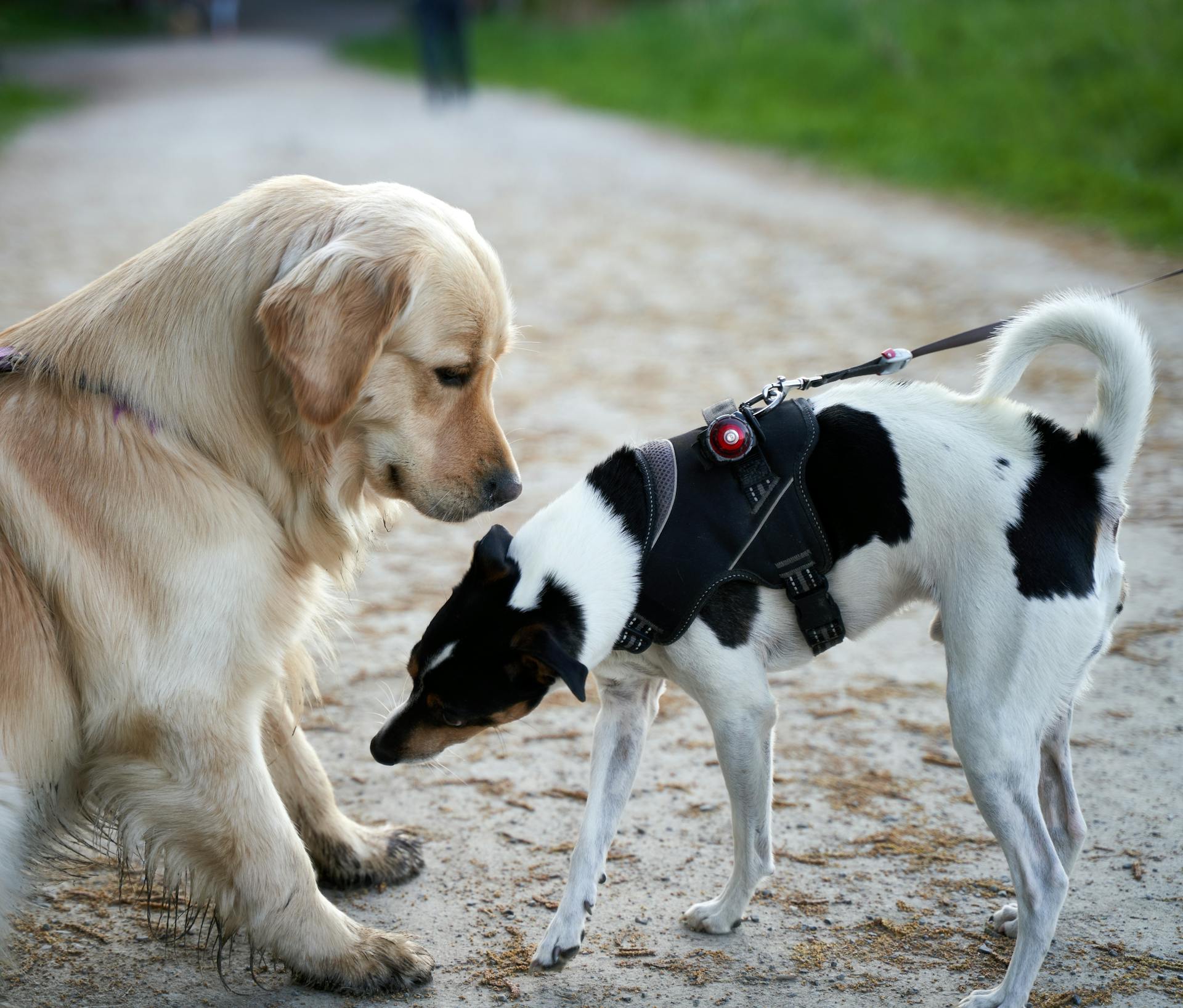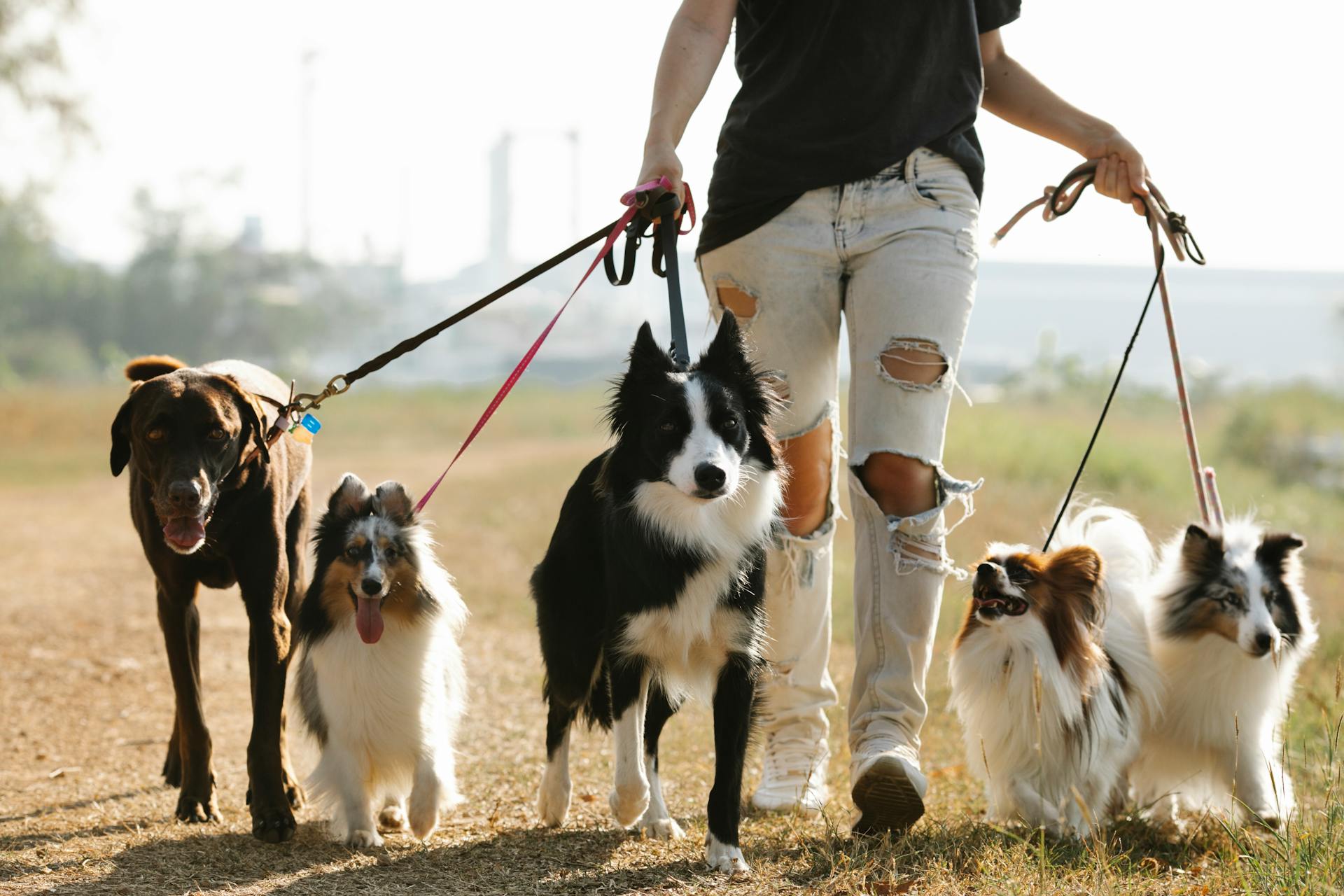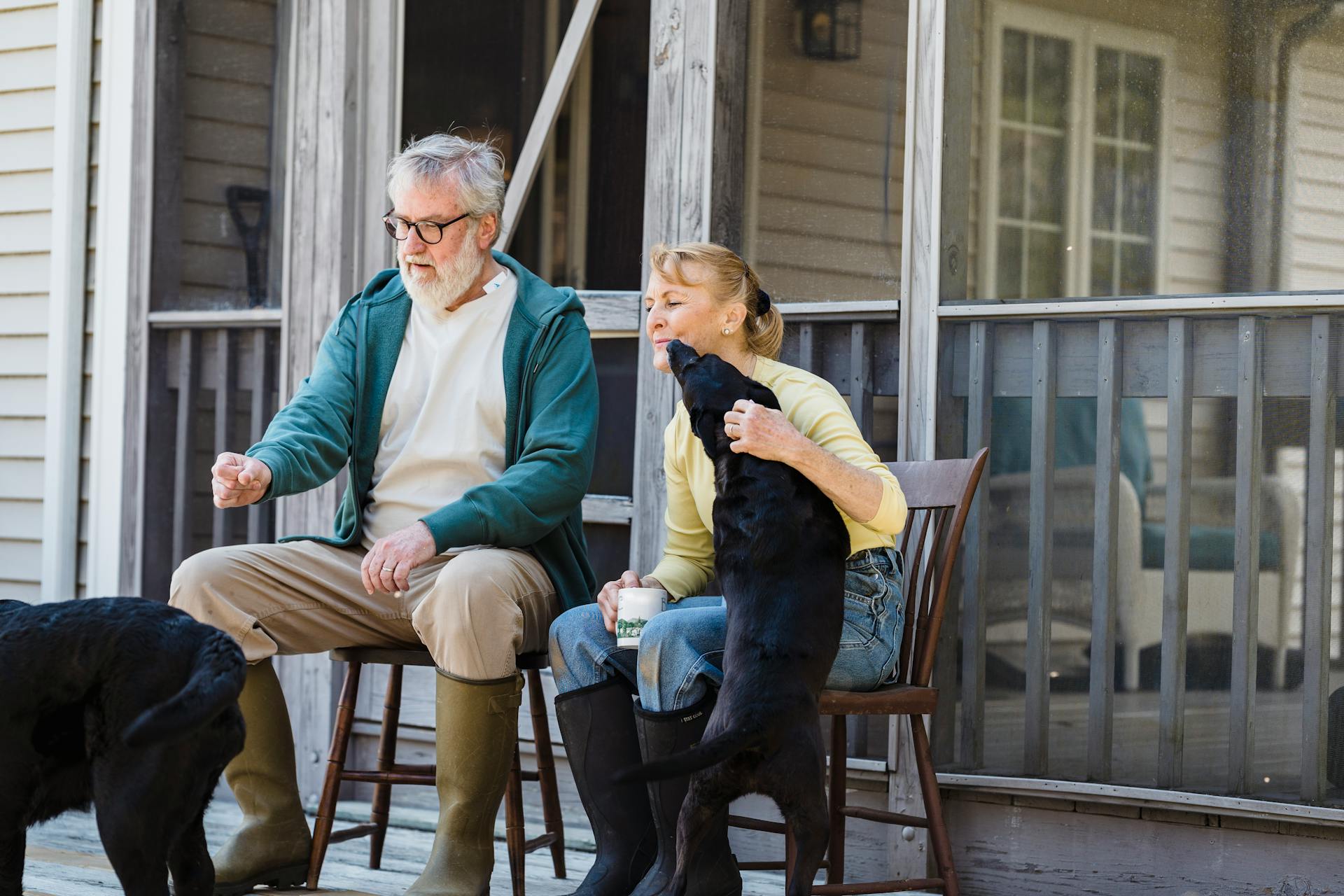
Dogs snap at their owners for a variety of reasons, but one of the main causes is fear or anxiety. If your dog feels threatened or scared, they may lash out in a snap.
Some common triggers for fear and anxiety in dogs include loud noises, strangers, and new environments. For example, fireworks can cause a dog to become fearful and snap at their owner.
Fear and anxiety can be caused by past experiences, genetics, and environmental factors. If your dog has had a traumatic experience in the past, they may become fearful and snap at you in similar situations.
To prevent your dog from snapping at you, it's essential to identify the underlying cause and address it.
Understanding Aggression
Aggression in dogs is often rooted in fear or resource guarding. Most aggressive behavior from dogs is on some level rooted in fear, where a dog might be fearful of something or someone getting close to them, or into their space.
Resource guarding, on the other hand, is a behavior where a dog becomes protective of their food, toys, or other valuable resources. If you try to take a toy or object out of your dog's mouth and they snap at you, they might be exhibiting resource guarding behavior.
A growl is a good thing, not a bad sign of aggression. In fact, a growl is something to be greatly treasured, as it's a warning sign that your dog is trying to communicate with you and doesn't want to bite or fight.
On a similar theme: Why Does My Blue Heeler Growl at Me
Fear
Fear is a common root of aggressive behavior in dogs. Most aggressive behavior from dogs is on some level rooted in fear. A dog might be fearful of something or someone getting close to them, or into their space.
If a dog feels overwhelmed or "over threshold" due to fear, they may respond by biting. For the dog biting out of fear, it's generally about trying to create distance from whatever or whoever they are worried about.
Dogs may become fearful due to various reasons, including being startled or spooked. If a dog is startled, especially if they have been sleeping, they may be disoriented and confused about where they are and what's going on, and might bite.
It's essential to figure out why your dog reacted with aggression, so you can help your dog not react to those situations in the future. Fear can elicit sudden behavioral and temperament changes such as aggression, which might be temporary or a sign of a deeper issue.
Your Dog is in Pain
Your dog is in pain, and it's not always easy to tell. Dogs are experts at hiding illness, a natural response to avoid showing weakness to predators. If your dog is hurting, they might snap at you when you touch a sore spot, not because they're aggressive, but because it hurts just like it would if someone touched a wounded part of your body.
Arthritis, cancer, fractures, hip dysplasia, skin infections, skin injuries or abrasions, hematomas, and physical injuries can all cause pain in dogs. These are just a few examples of the many potential causes.
Dogs in pain can become stressed, scared, and overwhelmed, leading them to bite when handled. If your dog is injured, be extra cautious when lifting or moving them, as they may bite in response to pain.
Some common signs of pain in dogs include responding negatively to touch in a specific area, displaying other signs of potential injury or illness, and suddenly changing their behavior. If you notice any of these signs, it's crucial to schedule a vet appointment right away.
Here are some potential causes of pain in dogs:
- Arthritis
- Cancer
- Fractures
- Hip dysplasia
- Skin infections
- Skin Injuries or abrasions
- Hematomas
- Physical injury
Resource Guarding
Resource Guarding is a common behavior in dogs, where they become protective of their food, toys, or other objects.
If your dog snaps at you when you try to take a toy or object out of their mouth, they might be exhibiting resource guarding behavior.
This behavior can develop during puppyhood and if not properly trained, can bleed into their adult life.
Food aggression, a type of resource guarding, is usually pretty easy to spot and can lead to growling, fighting, and biting other animals or humans.
Toy aggression, on the other hand, is usually aimed at other dogs or objects, not humans, and can be managed at home with proper training.
If resource guarding has resulted in biting and aggressive tendencies towards humans, it's time to seek professional help from a trainer or behavioral consultant.
A professional can develop a training plan tailored to your dog's specific needs to help manage this behavior.
A Growl is a Form of Communication
A growl is a form of communication, not a sign of aggression. Dogs growl to warn us away from their comfort zone.
Most dogs don't want to bite or fight, but will try to make us go away if we invade their space. Their threats may intensify if ignored, with more tension, a hard stare, and a low growl.
Explore further: Why Does My Great Pyrenees Growl at Me
If a dog feels compelled to bite, it's often a last resort to protect themselves, territory, or loved ones. They may try to avoid biting by using air snaps, bumps, or gentle mouth contact.
Ignoring a dog's growl or other warning signs can lead to more severe behavior problems. It's essential to recognize and respect their communication efforts to prevent escalation.
Dogs can't communicate like humans do, so it's crucial to understand their body language and physical markers. By doing so, we can build a stronger bond with our canine companions and address potential aggression issues early on.
Diagnosis
Diagnosis is a crucial step in understanding aggression in dogs. Your veterinarian will ask for a detailed history of your dog, including his home environment, habits, routines, discipline, training, and any other questions they feel necessary.
A complete examination by the veterinarian may include medical testing, such as blood work and a urinalysis. You should inform your veterinarian of any changes in diet or symptoms of illness.
The veterinarian will check for anxiety issues by asking specific questions, and may also investigate dominance issues.
Managing Aggressive Behavior
Working to stop your dog's sudden aggression is crucial for both you and your dog's overall happiness. Start by ruling out health issues to ensure there's no underlying medical cause.
Limiting exposure to triggers is also essential while you're working through an aggression issue. This means no visitors, no petting, and keeping your dog on a leash at all times when on walks or in public.
If your dog growls, snaps, or bites, it's tempting to want to punish the behavior, but this can actually make the situation worse. A growl or air snap without making contact is a dog's natural way of warning that they're extremely uncomfortable or overwhelmed.
Treating a growl as a good thing is a game-changer in managing aggressive behavior. By not punishing your dog for growling, you can actually prevent a dog bite from occurring in the future.
For more insights, see: Dog Food for Dogs with No Teeth
Managing Sudden Outbursts
Working to stop your dog's sudden aggression is very important for both you and your dog's overall happiness.
See what others are reading: Why Does My Male Dog Lick My Female Dog's Pee
Limiting exposure to triggers is crucial during this process, so establish a no-visitor and no-petting rule to prevent stress and potential bites.
Avoiding flooding or overwhelming situations is key to preventing anxiety and bites. Exposing your dog to prolonged or large amounts of things that scare or overwhelm them can have negative consequences.
Your dog's comfort or tolerance for stimulating or stressful situations can shift depending on factors like stress levels, fatigue, and unfamiliar situations. For example, a sudden birthday party at home can be overwhelming for a dog who hasn't had visitors in a year.
Removing your dog from stressful or overstimulating situations before they become overwhelming is essential. This proactive approach helps prevent escalation to biting and promotes your dog's comfort and well-being.
Don't Punish
Punishing your dog for growling or showing aggression is not only ineffective, but it can actually make the situation worse. A growl or air snap without making contact is a dog's natural way of warning that they're extremely uncomfortable or overwhelmed by a situation.
Dogs don't growl or snap to be aggressive, but rather to warn you to leave them alone. If your dog is punished for growling, it's likely to increase the likelihood of a dog bite occurring in the future.
Punishing a dog for growling can be especially counterproductive, as it teaches them not to warn you by growling or snapping, and instead go directly to a bite response when uncomfortable. This can lead to more serious and dangerous behavior problems.
A growl is not a sign of aggression, but rather a communication effort from your dog to warn you to leave them alone. If you continue to invade their comfort zone, their threats may intensify, with more tension, a hard stare, and a low growl.
Suggestion: Dog Bite
Communication and Support
Dogs can't communicate with us like we do, and that's why understanding their body language is crucial. We can only comprehend their communication as far as we can read their physical cues.
If your dog snaps at you, it's essential to address the issue before it becomes a habitual behavior. Consulting professionals, such as positive reinforcement trainers, can help you identify the underlying cause and develop a plan to rectify the behavior.
A positive reinforcement trainer can help you understand your dog's behavior and set them up for success in situations that might trigger aggression. This might mean giving your dog a safe spot away from the action or avoiding letting them off-leash.
Dogs often exhibit subtle signs of discomfort before escalating to more intense behaviors. These signs can include tension in body movements, a stiffly wagging tail, or a hard stare. If you ignore these warnings, your dog may become more insistent, leading to more severe behaviors like growling or snapping.
Here are some key things to keep in mind when dealing with a dog that snaps at you:
- Exhaust all resources before giving up on your dog.
- Consult professionals, such as positive reinforcement trainers, to help you understand your dog's behavior.
- Watch for subtle signs of discomfort, such as tension in body movements or a stiffly wagging tail.
- Give your dog a safe spot away from the action or avoid letting them off-leash.
- Help your dog build new associations to situations that are scary, stressful, or overwhelming.
By understanding your dog's communication and seeking support from professionals, you can help your dog feel more comfortable and reduce the likelihood of snapping. Remember, dogs often try to warn us away from their comfort zone before resorting to more severe behaviors.
Recovery and Treatment
Recovery from aggression toward familiar people in dogs takes time, perhaps years, and requires dedication and persistence from the whole family.
The veterinarian will usually recommend a tailored program to help your dog and your family, which may include behavioral therapy, medication, or changes to your home environment.
This therapy may involve modification of your dog's behavior, desensitization, eliminating triggers, training, and more, and may take time to show results.
Making sure your home environment is calm and predictable is crucial, as an unpredictable routine can exacerbate aggression.
With early intervention and the right treatment, your dog's chances of recovery are much higher.
Consistent follow-up visits with the veterinarian and behavioral therapist are necessary to ensure your dog is on the path to recovery.
For another approach, see: Are Boxer Dogs Good Family Dogs
Health Issues
Health Issues can be a major contributor to aggression in dogs. Many common health problems can affect your dog's personality, especially as they age.
Sudden aggression in an older dog may be related to canine cognitive dysfunction or dementia, which can lead to rapid mood changes. Brain damage to specific areas of the brain from tumors, thyroid issues, and trauma can also result in aggression problems.

Other symptoms to look out for include hair loss, weight gain, or lethargy, which could be a sign of hypothyroidism. Convulsions and seizures can also cause aggression in dogs.
Ear infections can cause aggression in the presence of loud noises, and dental issues can make eating a grueling experience for your dog. Take note of any other symptoms, such as vomiting, diarrhea, loss of appetite, and lethargy, and write this information down to share with your veterinarian.
Injury
Injury can be a sneaky source of sudden aggression in dogs, as they often hide pain well.
A cursory physical exam is a great place to start, looking for swelling, cuts, torn paw pads, insect stings, or tender spots that could be hurting your dog.
Checking the inside of your dog's mouth can also reveal a foreign object causing the aggression, such as a piece of food, toy, or stick caught in their teeth.
If you're not sure what's going on, it's best to leave the oral exam to your veterinarian, especially if your dog is feeling snappy.
Recovery
Recovery is a long process, and it takes much dedication and time from you, the loving and patient owner. Many dogs who display aggression towards familiar people are rehomed or surrendered to an animal shelter.
Recovery takes time, perhaps years, and over this time the methods learned must be followed. Follow-up visits with the veterinarian and behavioral therapist (if the therapy has ended) are necessary to be sure the dog is on the path to recovery.
There is no "cure" for dog aggression; however, there are ways to drastically minimize any recurrences. It takes dedication and persistence from the whole family in order to help the dog with this condition.
Making sure that your home environment is calm and predictable is crucial for a dog's recovery. If you do not have a routine with your dog, and his day-to-day living is very unpredictable, a change will need to be made.
The dog's chances of recovery are much higher if he is taken to the veterinarian and started on therapy early on. If a dog has attacked a person, causing suffering and severe injury, they may be euthanized.
For more insights, see: Service and Therapy Dogs
Sources
- https://www.dogster.com/dog-health-care/my-dog-snapped-at-me
- https://wagwalking.com/condition/aggression-toward-familiar-people
- https://www.thesprucepets.com/sudden-aggressive-behavior-in-dogs-1118591
- https://www.akc.org/expert-advice/training/why-do-dogs-bite/
- https://www.whole-dog-journal.com/behavior/understand-why-your-dog-growls/
Featured Images: pexels.com


